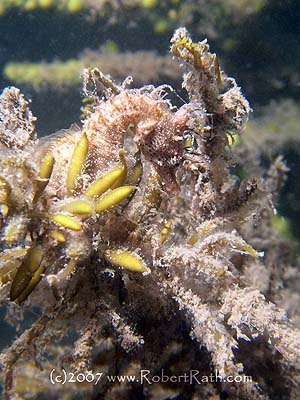
This photo taken last night should have been called "Master of Disguise" or "Guess What". Peering closely amid the algae and the silt you will see a Short-Head Seahorse,
Hippocampus breviceps. This photo is an excellent example of how these little guys make themselves virtually invisible to both predators and photographers.
The Short-Head Seahorse is very common in the waters of southern Australia. They love areas that have good weedy habitat and can generally be found attached to seagrasses, sargassum weed and amongst the growth on jetty pylons. They can also be found in sponge gardens, especially on sponges in deeper water. They often occur in small groups and at night time they can be found congregating high on the weed to avoid predators. They are known to feed on small species such as mysids. They can be found from shallow water to at least 15 metres deep. They breed on a monthly cycle throughout summer and produce about 50 to 100 eggs in a brood. The Short-Head Seahorse grows to a maximum size of approximately 10cm.
Yes, as you guessed it we had a sensational Easter at Edithburgh with some great diving and great photos too, so stay tuned for more.
Until the next post, take care out there and keep diving ( if that's what you do! ) ...Robert
 Photo: Robert Rath C5060 1/45s at f/6.7 ISO100 Inon D2000 Strobe
Photo: Robert Rath C5060 1/45s at f/6.7 ISO100 Inon D2000 Strobe